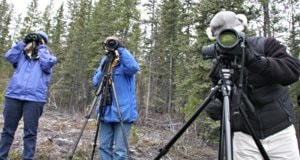Thomas Hafen arrived in Whitehorse from Munich, Germany on Tuesday, with one thing on his mind — birds.
Diehard birdwatchers, or birders, scuttle across the globe with a passion for the winged beast that is hard for outsiders to grasp.
“I’ve got a list,” said Hafen, crouched behind his Leica spotting scope on Wednesday night, a flotilla of scaups and buffleheads bobbing on the pumphouse pond in his viewfinder.
“I’ve already got four of them checked off… the easy ones.”
He plans to spend the next month covering most of the swath between Skagway and the Dempster, searching for species he’s never seen in Europe.
For Yukon birders, now is the time for spotting, as more than 200 different species follow their spring migration routes through the territory, coming from as far away as Argentina, destined for the coast of the Beaufort Sea or northwest Alaska.
Hafen joined half a dozen local birders from the Yukon Bird Club on Wednesday, hoping to get some advice from the locals.
“Let me see your list,” said Cameron Eckert, who was leading the birders around the small ponds on Fish Lake Road.
“Oh yeah, lots of these are doable,” he told Hafen.
“He’s looking at his list, thinking, “Where am I going to see a tattler?” said Eckert, a conservation biologist, who gets a lot of calls from those looking to find that elusive bird.
“That’s when I can help people out. It’s like, tattler? Lake Laberge — for the next two weeks, you’ll see a tattler there.”
And you’d be surprised the lengths people will go to in the hunt for that certain feathered friend.
“There’s no end to the intensity of birders,” said Eckert. “I’ve guided really elderly folks, walking with canes, right to the top of Montana Mountain and McIntyre Mountain in search of the timberline brewer sparrow, the most dingy sparrow you could ever imagine,” he laughed. “It has virtually no colour.”
Whitehorse is a great spot for birders, said Eckert.
The territory has an enormous diversity of habitats and ecosystems all within walking distance from most peoples’ front doors.
“We have mountains, dry upland forests, incredible staging areas during migration, we get upwards of tens of thousands of birds passing through every season.”
Wednesday night’s viewing was a success, despite the unseasonable cold.
“I thought tonight was fantastic,” said Eckert. “We got to see the rough winged swallow, which we hardly ever see. And we got to see some of the first migrant warblers of the season — Wilson’s warbler, the yellow-rumped warbler, and the common yellowthroat — which are all really bright and attractive birds, and we got an excellent scope view of an eagle’s nest.”
The McIntyre creek wetland is probably the richest wetland system within the city of Whitehorse, added Eckert.
“It’s a place that gets phenomenal concentrations of birds, especially on cold nights like tonight.”
What is it about birds that gets people so exited?
Eckert tried to sum it up: “With birds, you have a diversity that you can get a handle on. The average person, with some effort, can understand the range of birds that are around us, and that every different species occupies a different spot on the landscape, a different habitat type. Understanding a bit more about birds is a window on the natural world, it helps to interpret what’s out there.
“A lot of birdwatchers have that epiphany moment, which is like, ‘look at that yellow bird — now, I never knew a bird that yellow existed, anywhere’ and they go to the shelf and pickup their grandfather’s 1945 Roger Tory Peterson birding guide.
“They figure out it’s a Wilson’s warbler, and that is often the catalyst to looking beyond, and away they go.”
Yukon Bird Club member Helmut Grunberg has a simpler explanation.
“Different people like different things,” he says. “Some people like art, some people like soccer.”
Grunberg likes birds, and he’s been watching them for 56 years. He’s still writing down all the names of the birds he finds and the birders he meets.
You can get your name into Grunberg’s book by checking out one of the Yukon Bird Club’s upcoming field trips during this peak migration season, including the Judas Creek Migration Finality, next Wednesday.
Eckert described it as a good chance to see some shorebirds up close, and maybe more.
“Whenever you get shorebirds assembling, it may attract a falcon or raptor of some sort,” he said.
The trip is scheduled to meet at the SS Klondike at 5:50 p.m., before heading to Marsh Lake.
The Weekend on the Wing Festival, June 9 to 11 at Tombstone Territorial Park, is a chance to see Arctic and sub-Arctic birds in their breeding habitat.
The festival includes talks, interpretive programs and walks covering the range of habitats.
For more information on Yukon Bird Club activities, check out its website at
www.yukonweb.com/community/ybc.
